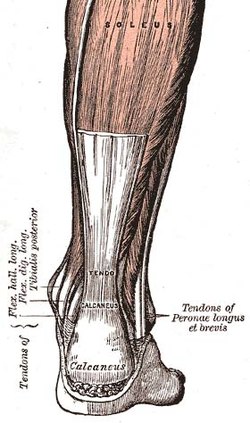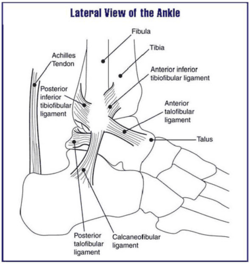Achilles tendons
| Achilles tendon | |
|---|---|

Posterior view of the foot and leg, showing the Achilles tendon (tendo calcaneus). The gastrocnemius muscle is cut to expose the soleus.
|
|

Lateral view of the human ankle, including the Achilles tendon
|
|
| Details | |
| Identifiers | |
| Latin | tendo calcaneus, tendo Achillis |
| MeSH | A02.880.176 |
| Dorlands /Elsevier |
t_04/12793915 |
| TA | A04.7.02.048 |
| FMA | 51061 |
|
Anatomical terminology
[]
|
|
The Achilles tendon or heel cord, also known as the calcaneal tendon (Latin: Tendo calcaneus), is a tendon of the back of the leg, and the thickest in the human body. It serves to attach the plantaris, gastrocnemius (calf) and soleus muscles to the calcaneus (heel) bone. These muscles, acting via the tendon, cause plantar flexion of the foot at the ankle, and (except soleus) flexion at the knee.
The tendon can rupture and become inflamed.
The oldest-known written record of the tendon being named for Achilles is in 1693 by the Flemish/Dutch anatomist Philip Verheyen. In his widely used text Corporis Humani Anatomia, Chapter XV, page 328, he described the tendon's location and said that it was commonly called "the cord of Achilles" ("quae vulgo dicitur chorda Achillis"), now also called "tendo achillies" by anatomists. Verheyen referred to the mythological account of Achilles being held by the heel when dipped in the River Styx to protect his body from harm.
The Achilles tendon is also known as the calcaneal tendon. Because eponyms (names relating to people) have no relationship to the subject matter, most anatomical eponyms also have scientifically descriptive terms. The term calcaneal comes from the Latin calcaneum, meaning heel.
The Achilles tendon connects muscle to bone, like other tendons, and is located at the back of the lower leg. The Achilles tendon connects the gastrocnemius and soleus muscles to the calcaneal tuberosity on the calcaneus (heel bone). The tendon begins near the middle of the calf, and receives fleshy fibers on its inner surface, almost to its lower end. Gradually thinning below, it inserts into the middle part of the back of the calcaneus bone. The tendon spreads out somewhat at its lower end, so that its narrowest part is about 4 centimetres (1.6 in) above its insertion.
...
Wikipedia
